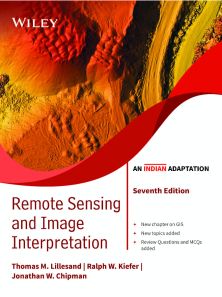Remote Sensing and Image Interpretation,7ed (An Indian Adaptation)
ISBN: 9789354642104
For more information write to us at: acadmktg@wiley.com

Description
Remote Sensing and Image Interpretation is designed to be primarily used in two ways: as a textbook in the introductory courses in remote sensing and image interpretation, and as a reference for the burgeoning number of practitioners who use geospatial information and analysis in their work. Because of the wide range of academic and professional settings in which this book might be used, the discussion has been made “discipline neutral.” In short, anyone involved in geospatial data acquisition and analysis should find this book to be a valuable resource.
Chapter 1 Concepts and Foundations of Remote Sensing
1.1 Introduction
1.2 Energy Sources and Radiation Principles
1.3 Energy Interactions in the Atmosphere
1.4 Energy Interactions with Earth Surface Features
1.5 Data Acquisition and Digital Image Concepts
1.6 Reference Data
1.7 Satellite Navigation Systems
1.8 Characteristics of Remote Sensing Systems
1.9 Successful Application of Remote Sensing
1.10 Geographic Information Systems (GIS)
1.11 Spatial Data Frameworks for GIS and Remote Sensing
1.12 Visual Image Interpretation
Chapter 2 Elements of Photographic Systems
2.1 Introduction
2.2 Early History of Aerial Photography
2.3 Photographic Basics
2.4 Digital Photography
2.5 Aerial Cameras
2.6 Spatial Resolution of Camera Systems
2.7 Aerial Videography
2.8 Conclusion
Chapter 3 Basic Principles of Photogrammetry
3.1 Introduction
3.2 Basic Geometric Characteristics of Aerial Photographs
3.3 Photographic Scale
3.4 Ground Coverage of Aerial Photographs
3.5 Area Measurement
3.6 Relief Displacement of Vertical Features
3.7 Image Parallax
3.8 Ground Control for Aerial Photography
3.9 Determining the Elements of Exterior Orientation of Aerial Photographs
3.10 Production of Mapping Products from Aerial Photographs
3.11 Flight Planning
3.12 Conclusion
Chapter 4 Multispectral, Thermal, and Hyperspectral Sensing
4.1 Introduction
4.2 Across-Track Scanning
4.3 Along-Track Scanning
4.4 Example Across-Track Multispectral Scanner and Imagery
4.5 Example Along-Track Multispectral Scanner and Imagery
4.6 Geometric Characteristics of Across-Track Scanner Imagery
4.7 Geometric Characteristics of Along-Track Scanner Imagery
4.8 Thermal Imaging
4.9 Thermal Radiation Principles
4.10 Interpreting Thermal Imagery
4.11 Radiometric Calibration of Thermal Images and Temperature Mapping
4.12 FLIR Systems
4.13 Hyperspectral Sensing
4.14 Conclusion
Chapter 5 Earth Resource Satellites Operating in the Optical Spectrum
5.1 Introduction
5.2 General Characteristics of Satellite Remote Sensing Systems Operating in the Optical Spectrum
5.3 Moderate Resolution Systems
5.4 Landsat-1 to -7
5.5 Landsat-8
5.6 Future Landsat Missions and the Global Earth Observation System of Systems
5.7 SPOT-1 to -5
5.8 SPOT-6 and -7
5.9 Evolution of Other Moderate Resolution Systems
5.10 Moderate Resolution Systems Launched Prior to 1999
5.11 Moderate Resolution Systems Launched Since 1999
5.12 High Resolution Systems
5.13 Hyperspectral Satellite Systems
5.14 Meteorological Satellites Frequently Applied to Earth Surface Feature Observation
5.15 NOAA POES Satellites
5.16 JPSS Satellites
5.17 GOES Satellites
5.18 Ocean Monitoring Satellites
5.19 Earth Observing System
5.20 Space Station Remote Sensing
5.21 Space Debris
Chapter 6 Microwave, Lidar, and Geophysical Sensing
6.1 Introduction
6.2 Radar Development
6.3 Imaging Radar System Operation
6.4 Synthetic Aperture Radar
6.5 Geometric Characteristics of Radar Imagery
6.6 Transmission Characteristics of Radar Signals
6.7 Other Radar Image Characteristics
6.8 Radar Image Interpretation
6.9 Interferometric Radar
6.10 Radar Remote Sensing from Space
6.11 Seasat-1 and the Shuttle Imaging Radar Missions
6.12 Almaz-1
6.13 ERS, Envisat, and Sentinel-1
6.14 JERS-1, ALOS, and ALOS-2
6.15 Radarsat
6.16 TerraSAR-X, TanDEM-X, and PAZ
6.17 The COSMO-SkyMed Constellation
6.18 Other High-Resolution Spaceborne Radar Systems
6.19 Shuttle Radar Topography Mission
6.20 Spaceborne Radar System Summary
6.21 Radar Altimetry
6.22 Passive Microwave Sensing
6.23 Basic Principles of Lidar
6.24 Lidar Data Analysis and Applications
6.25 Spaceborne Lidar
6.26 Space Gravity Data Analysis and Applications
Chapter 7 Digital Image Analysis
7.1 Introduction
7.2 Preprocessing of Images
7.3 Image Enhancement
7.4 Contrast Manipulation
7.5 Spatial Feature Manipulation
7.6 Multi-Image Manipulation
7.7 Image Classification
7.8 Supervised Classification
7.9 The Classification Stage
7.10 The Training Stage
7.11 Unsupervised Classification
7.12 Hybrid Classification
7.13 Classification of Mixed Pixels
7.14 The Output Stage and Postclassification Smoothing
7.15 Object-Based Classification
7.16 Neural Network Classification
7.17 Classification Accuracy Assessment
7.18 Change Detection
7.19 Image Time Series Analysis
7.20 Data Fusion and GIS Integration
7.21 Hyperspectral Image Analysis
7.22 Biophysical Modeling
7.23 Conclusion
Chapter 8 Applications of Remote Sensing
8.1 Introduction
8.2 Land Use/Land Cover Mapping
8.3 Basic Geological Applications
8.4 Mineral Exploration
8.5 Groundwater and Springs
8.6 Soil Mapping
8.7 Agricultural Applications
8.8 Forestry Applications
8.9 Rangeland Applications
8.10 Water Resource Applications
8.11 Snow and Ice Applications
8.12 Glaciers and Climate Change Applications
8.13 Marine and Coastal Applications
8.14 Wetland Mapping
8.15 Wildlife Ecology Applications
8.16 Urban and Regional Planning Applications
8.17 Archaeological Applications
8.18 Natural Disaster Assessment
8.19 Environmental Assessment and Protection
8.20 Global Navigation Satellite Systems
8.21 Planetary Sciences Applications
8.22 Conclusion
Chapter 9 Geographic Information Systems
9.1 Introduction to GIS
9.2 Spatial Data Models and Structures
9.3 Geospatial Data Input and Management
9.4 Visualization and Data Exploration
9.5 Spatial Data Transformation and Analysis
9.6 Spatial Data Modeling
9.7 Planning, Implementation, and Management of GIS
9.8 Current Issues and Trends in GIS
9.9 Conclusion
Review Questions
Multiple Choice Questions
SI Units Frequently Used in Remote Sensing
Works Cited
Index

